Litóhoro, Pieria, Greece, Sunday through Tuesday, 11-13 March 2001
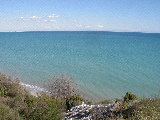
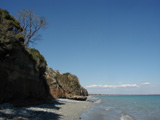
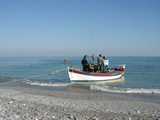 We have started taking walks down by the sea, which involve taking the Kateríni buses just as far as the coastal highway and back. I went first by myself on 4 February, walked north, and saw this fishing boat land up near Litóhoro's harbor at Grítsa. (This was at the start of a week of fair weather that followed several weeks of overcast and rain; I took advantage by going out walking for hours every day, alternating trips to the beach with trips to the mountain.) Thereafter I brought along first Larissa and then the rest of the family. The beach is a rather narrow strip beneath low cliffs made up of conglomerate, a kind of natural concrete--which we have also seen used for ancient block walls on the south slope of the Athenian Acropolis. One can climb down at nearly any of numerous notches in the plateau edge, though some of the paths are rather rough going, especially the one directly across from the bus stop.
We have started taking walks down by the sea, which involve taking the Kateríni buses just as far as the coastal highway and back. I went first by myself on 4 February, walked north, and saw this fishing boat land up near Litóhoro's harbor at Grítsa. (This was at the start of a week of fair weather that followed several weeks of overcast and rain; I took advantage by going out walking for hours every day, alternating trips to the beach with trips to the mountain.) Thereafter I brought along first Larissa and then the rest of the family. The beach is a rather narrow strip beneath low cliffs made up of conglomerate, a kind of natural concrete--which we have also seen used for ancient block walls on the south slope of the Athenian Acropolis. One can climb down at nearly any of numerous notches in the plateau edge, though some of the paths are rather rough going, especially the one directly across from the bus stop.
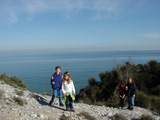
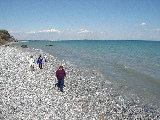
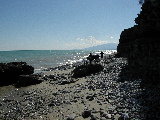 The beach varies between sand and pebbles. The latter sort naturally reminds the English major or professor of Arnold's lines in "Dover Beach," about the "grating roar . . . with tremulous cadence slow" made by waves on such shores--and especially how "Sophocles long ago / Heard it on the Aegean." The mountain off in the distance in the photo on right (looking south) is Ossa, on top of which the giants of Greek myth attempted to pile Mount Pelion (which is yet further south along this coast), in order to overtop Olympus. Even thus far in the distance, Ossa is no mere wart, whatever Hamlet says.
The beach varies between sand and pebbles. The latter sort naturally reminds the English major or professor of Arnold's lines in "Dover Beach," about the "grating roar . . . with tremulous cadence slow" made by waves on such shores--and especially how "Sophocles long ago / Heard it on the Aegean." The mountain off in the distance in the photo on right (looking south) is Ossa, on top of which the giants of Greek myth attempted to pile Mount Pelion (which is yet further south along this coast), in order to overtop Olympus. Even thus far in the distance, Ossa is no mere wart, whatever Hamlet says.
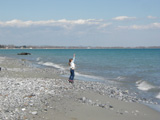 Perhaps as eternal as Arnold's "note of sadness" is the urge for children to throw in stones.
Perhaps as eternal as Arnold's "note of sadness" is the urge for children to throw in stones.
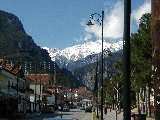
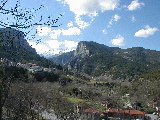
 Olympus in February was at its snowiest, shown here at left from (and with) the main street of the town, Áyios Nikólaos; from a terrace just off the central platía, at the top of that street; and from down by the coast.
Olympus in February was at its snowiest, shown here at left from (and with) the main street of the town, Áyios Nikólaos; from a terrace just off the central platía, at the top of that street; and from down by the coast.
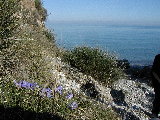
 The wildflowers of Greece start appearing very early (or perhaps rather never fail--throughout the winter, it seemed, some species was always to be found blooming somewhere). The wild irises understandably appeared by the shore (left, 6 February) rather earlier than up towards the mountain (right, 24 February).
The wildflowers of Greece start appearing very early (or perhaps rather never fail--throughout the winter, it seemed, some species was always to be found blooming somewhere). The wild irises understandably appeared by the shore (left, 6 February) rather earlier than up towards the mountain (right, 24 February).

 The little shrine shown left, the cutest in town, stands beside the very choice playground we discovered some while back at the very top of the town, along an alternate route to the main mountain trail-head. At right, you see Ariadne partway up a little pinnacle that stands off from the Gólna slope. The Priónia trail threads the saddles just inside a series of these pinnacles, and at these points commands particularly fine prospects; at this particular one, there are even some benches thoughtfully placed for the weary.
The little shrine shown left, the cutest in town, stands beside the very choice playground we discovered some while back at the very top of the town, along an alternate route to the main mountain trail-head. At right, you see Ariadne partway up a little pinnacle that stands off from the Gólna slope. The Priónia trail threads the saddles just inside a series of these pinnacles, and at these points commands particularly fine prospects; at this particular one, there are even some benches thoughtfully placed for the weary.

 On one of my trips upward, in which I was accompanied as so often just by Larissa, we started exploring a branch off the main trail, and eventually wound up scrambling straight up the slope, with no path at all, until we reached the little chapel of Profítis Ilías, which appears very tiny in many of my photos of the mountain from the village, and really is rather tiny at that. It commands a wonderful view of the town, though. We came back down by road, much easier but relatively boring.
On one of my trips upward, in which I was accompanied as so often just by Larissa, we started exploring a branch off the main trail, and eventually wound up scrambling straight up the slope, with no path at all, until we reached the little chapel of Profítis Ilías, which appears very tiny in many of my photos of the mountain from the village, and really is rather tiny at that. It commands a wonderful view of the town, though. We came back down by road, much easier but relatively boring.
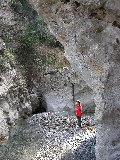
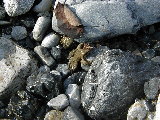
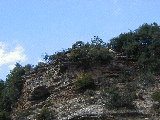 On another occasion Larissa and I went down to the river where it flows past the town, and walked up the valley floor as high as we could. (We were stopped at the point shown on left). On the way we saw this and other goats doing what goats do best, and this frog. The frog kept mum, so I cannot confirm what I heard rumored in college, that Greek frogs still croak "Brekekekex koax koax" (as Aristophanes wrote it in the "croaking chorus" of his comedy), as opposed to "Ribet, ribet."
On another occasion Larissa and I went down to the river where it flows past the town, and walked up the valley floor as high as we could. (We were stopped at the point shown on left). On the way we saw this and other goats doing what goats do best, and this frog. The frog kept mum, so I cannot confirm what I heard rumored in college, that Greek frogs still croak "Brekekekex koax koax" (as Aristophanes wrote it in the "croaking chorus" of his comedy), as opposed to "Ribet, ribet."
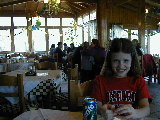 On the way back that day we stopped for refreshments at the little taverna by the trail head, which had some decorations up, as it was carnival (Mardi Gras) time. Carnival in Litóhoro was a bit disappointing, though. As usual, we were not well informed about when and where the best glimpses of it were to be had. We were advised to be in the main platía at seven Friday night. We were a bit later than that getting there, but I was encouraged to see a TV truck that was setting up rather than packing up; still, we waited in vain for anything particularly noteworthy beyond a few extra people milling about, some of them in costume, and a few vendors of balloons and popcorn. Saturday it started to blow rather hard, so Saturday night's bonfires were (one hopes) postponed; in any case we did not see any. We lost phone and thus also internet service to the gale (I guess) on Monday, and only got it back this past Friday afternoon.
On the way back that day we stopped for refreshments at the little taverna by the trail head, which had some decorations up, as it was carnival (Mardi Gras) time. Carnival in Litóhoro was a bit disappointing, though. As usual, we were not well informed about when and where the best glimpses of it were to be had. We were advised to be in the main platía at seven Friday night. We were a bit later than that getting there, but I was encouraged to see a TV truck that was setting up rather than packing up; still, we waited in vain for anything particularly noteworthy beyond a few extra people milling about, some of them in costume, and a few vendors of balloons and popcorn. Saturday it started to blow rather hard, so Saturday night's bonfires were (one hopes) postponed; in any case we did not see any. We lost phone and thus also internet service to the gale (I guess) on Monday, and only got it back this past Friday afternoon.
On Friday, 2 March, we hopped on the bus to Athens again. We stayed for five nights at the Marble House, where with the progress of the season the lack of heat has ceased to be a problem. This trip was by no means long planned, but after overdosing on travel last summer we were getting the itch again. Athens today is admittedly no glamorous model city, but for me, especially when I have been immersing myself in Plato as lately, it is--far, far more than Rome--the Eternal City, being both the mother-city of Western civilization and the site of much of the finest thinking and writing ever done on questions of what it means for human beings to live together in a city, and what is needed to make that work.
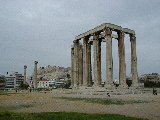
 I spent much of Saturday and all of Tuesday working in the library. On Sunday we went to the temple of Olympian Zeus, god of politics among other things. It is the largest of the ancient temples of Greece. Its foundations are pre-classical (sixth century B.C.), but the spectacular and huge Corinthian columns are of much later, post-classical date.
I spent much of Saturday and all of Tuesday working in the library. On Sunday we went to the temple of Olympian Zeus, god of politics among other things. It is the largest of the ancient temples of Greece. Its foundations are pre-classical (sixth century B.C.), but the spectacular and huge Corinthian columns are of much later, post-classical date.
Also on Sunday we visited the National Historical Museum, which occupies the old Voúli (parliament building) and holds relics from the 1821 war of independence and the later nineteenth and early twentieth centuries. There was a small display of Byron's sword and other personal belongings. Byron is a hero to the Greeks, as he fought and died in the war of independence, having doubtless contributed far more to the cause by his fame as a poet than by than his sword-arm. There were paintings of many of the heroes of the revolution, and a mitre belonging to the bishop of Smyrna, killed (according to the placard) by a Turkish mob in the Asia Minor "Catastrophe" of 1922. What struck me most of all were ships' figureheads from the revolution, large crude wooden heads of heroes from Greece's mythic and classical heritage, including Agamemnon, Themistocles, and Epaminondas.
We lunched at the same taverna where I had dined eight weeks before with Jerry Schnabel and Susan Scrivner. While we were there, a very talented pre-pubescent tenor was being filmed belting out Neapolitan songs including "O Solo Mio" [sic], just a few yards from our table.
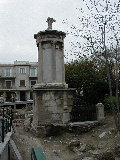 Near the eastern end of the half-pedestrianized and rather touristy warren of streets and lanes known as the Pláka stands this late-classical choregic monument, that of Lysicrates. (The classical period of ancient Greek history is commonly reckoned to have run from the battle of Marathon in 490 B.C. to the death of Alexander in 323 B.C.) This is the best preserved of what must have been a large number of such monuments. They were customarily erected by the chorus leaders (roughly equivalent to modern producers) of winning entries in the annual and competitive springtime tragedy festival in the Theater of Dionysus. An entry would consist of a whole day's program, comprising a coherent tetralogy of three tragedies plus kind of comic after-piece called a "satyr play," all by one poet. There would be three such entries each year, and they would be ranked by ten judges representing the ten political "tribes" into which the Athenian citizenry had been artificially divided by the political reformer Cleisthenes.
Near the eastern end of the half-pedestrianized and rather touristy warren of streets and lanes known as the Pláka stands this late-classical choregic monument, that of Lysicrates. (The classical period of ancient Greek history is commonly reckoned to have run from the battle of Marathon in 490 B.C. to the death of Alexander in 323 B.C.) This is the best preserved of what must have been a large number of such monuments. They were customarily erected by the chorus leaders (roughly equivalent to modern producers) of winning entries in the annual and competitive springtime tragedy festival in the Theater of Dionysus. An entry would consist of a whole day's program, comprising a coherent tetralogy of three tragedies plus kind of comic after-piece called a "satyr play," all by one poet. There would be three such entries each year, and they would be ranked by ten judges representing the ten political "tribes" into which the Athenian citizenry had been artificially divided by the political reformer Cleisthenes.
 That evening before dinner I took a short but energetic hike to the top of Mousíon Hill (surmounted by the monument of Philopappus, shown left with first-quarter moon), in order to catch the sunset over Salamis (below), and see the Acropolis in that light.
That evening before dinner I took a short but energetic hike to the top of Mousíon Hill (surmounted by the monument of Philopappus, shown left with first-quarter moon), in order to catch the sunset over Salamis (below), and see the Acropolis in that light.

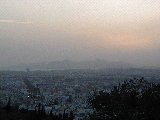

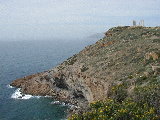
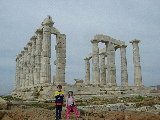
On Monday we took an Attic regional bus to Cape Sounion, where the picturesque ruin of a modest-sized Doric temple to Poseidon, god of the sea, surmounts a 60-meter-high headland. We first made our way by trolley a mile or so up north to the departure point, in time for what we thought would be a nine o'clock bus, only to discover that the buses ran now only once per hour on the half. While we were waiting Stas checked out a nearby "Internet Cafe," but it turned out not to have any internet service, which seemed like a very novel idea for such establishments. When we got going at last, we discovered that the bus made one stop along the way out of Athens--the tourist police had assured me it did not--and that stop was just a few blocks from our hotel. This bus ride took nearly two hours and shook us all up rather violently, the more so as the children had opted for the very back seats where we could all five sit across.

 Our guidebooks stressed the place's connection with Byron. He mentions the place in the "Isles of Greece" section of "Don Juan," and allegedly carved his name on a pillar here in 1810 ("an unfortunate precedent," notes The Rough Guide, one that was followed by far too many others). But it is also associated with the death of Socrates: after his trial, his execution had to await the completion of an annual sacred mission by the Athenians to the isle of Delos, birthplace of Apollo, and so to Socrates the ship returning past this cape was a harbinger of death (Plato, Crito 43d; Phaedo 58a-c). I imagine it would have been here also that King Aegeus awaited his son Theseus' return from his encounter with the Minotaur of Crete--and seeing the ship's black sail, mistakenly signifying Theseus' failure and death, leapt to his death in the sea that yet bears his name, the Aegean. (Certainly no place in Athens proper would be consistent with such a story. Also, Plato links the annual mission to Delos with the myth of Theseus and the Minotaur, and so these two associations would be connected.)
Our guidebooks stressed the place's connection with Byron. He mentions the place in the "Isles of Greece" section of "Don Juan," and allegedly carved his name on a pillar here in 1810 ("an unfortunate precedent," notes The Rough Guide, one that was followed by far too many others). But it is also associated with the death of Socrates: after his trial, his execution had to await the completion of an annual sacred mission by the Athenians to the isle of Delos, birthplace of Apollo, and so to Socrates the ship returning past this cape was a harbinger of death (Plato, Crito 43d; Phaedo 58a-c). I imagine it would have been here also that King Aegeus awaited his son Theseus' return from his encounter with the Minotaur of Crete--and seeing the ship's black sail, mistakenly signifying Theseus' failure and death, leapt to his death in the sea that yet bears his name, the Aegean. (Certainly no place in Athens proper would be consistent with such a story. Also, Plato links the annual mission to Delos with the myth of Theseus and the Minotaur, and so these two associations would be connected.)

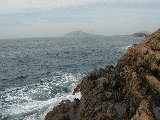

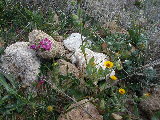 The children and I clambered down the promontory on the seaward side of the temple, right down to where the waves lapped the rock. Much of the rock below the top but above the shore is very peculiar, very crumbly with a pronounced grain, so that it crumbles into splinters. (These splinters cover the foreground of the photo at lower left here, though the photo does not show them sufficiently close up). I was unable to learn just what kind of rock this was, but the peninsula is noted for its unusual geology and mineral wealth: the notorious slave-worked mines of Laurium, a perpetual black mark against the civilization of classical Athens, were very near here.
The children and I clambered down the promontory on the seaward side of the temple, right down to where the waves lapped the rock. Much of the rock below the top but above the shore is very peculiar, very crumbly with a pronounced grain, so that it crumbles into splinters. (These splinters cover the foreground of the photo at lower left here, though the photo does not show them sufficiently close up). I was unable to learn just what kind of rock this was, but the peninsula is noted for its unusual geology and mineral wealth: the notorious slave-worked mines of Laurium, a perpetual black mark against the civilization of classical Athens, were very near here.
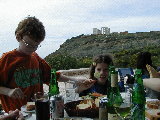 The taverna on the site was good and surprisingly merciful in its pricing, considering its monopoly and peerless location. As I awaited the bill while the family visited the souvenir shop, a vacationing biologist from Massachusetts General Hospital came by and struck up an acquaintance, which we continued on the bus back. The bus back was much fancier than the one we came out on, with much better suspension in particular, but after the first stop or two it got and stayed rather miserably crowded and hot.
The taverna on the site was good and surprisingly merciful in its pricing, considering its monopoly and peerless location. As I awaited the bill while the family visited the souvenir shop, a vacationing biologist from Massachusetts General Hospital came by and struck up an acquaintance, which we continued on the bus back. The bus back was much fancier than the one we came out on, with much better suspension in particular, but after the first stop or two it got and stayed rather miserably crowded and hot.
On Wednesday, 6 March, we revisited the theater of Dionysos, where I took some very purposeful photos for a colleague, before returning to Litóhoro.
Since returning to Litóhoro, Larissa and Trevor and I have become much captivated by a computer game, of the "sim-city" type, with an ancient Greek setting. Stas bought it along with a new laptop computer just before the Athens trip. The inhabitants of the virtual city-state must be kept supplied with (among other things) goat cheese and olive oil, which are distributed by handcart from agorai; and they can only really prosper if they are also in frequent contact with philosophers as well as athletic trainers from gymnasia. Olympian gods occasionally walk the streets for good or ill. There are some gaffes in the programming, like Olympian games beginning in 1000 B.C. (224 years too early), but it is much better than one would expect, very cute and great fun.
Yesterday, though, Monday 12 March, it was far too fine to stay indoors, so I took the children for a mountain hike, saying Zeus would be angry if we wasted such unbelievably fine weather on a computer game, even one named after him; so instead of "Master of Olympus: Zeus" we played Hiker of Olympus. (The new computer was in the shop anyway, as I have been unable to get its modem to connect with our ISP. My university-issued laptop is not supposed to be for that sort of thing, and anyhow its cooling system has become far too weak for game graphics--the machine often overheats and has to be shut down even when I am working with photos for this journal.) We retraced backwards the route Larissa and I had taken through the valley floor sixteen days earlier at carnival time, this time with no frog but much more wildflowers. There was also more barbed wire--two duckings-under needed rather than just one as before, and in between some mules with pack saddles grazing.
previous entry
next entry
main/ToC page


 The beach varies between sand and pebbles. The latter sort naturally reminds the English major or professor of Arnold's lines in "Dover Beach," about the "grating roar . . . with tremulous cadence slow" made by waves on such shores--and especially how "Sophocles long ago / Heard it on the Aegean." The mountain off in the distance in the photo on right (looking south) is Ossa, on top of which the giants of Greek myth attempted to pile Mount Pelion (which is yet further south along this coast), in order to overtop Olympus. Even thus far in the distance, Ossa is no mere wart, whatever Hamlet says.
The beach varies between sand and pebbles. The latter sort naturally reminds the English major or professor of Arnold's lines in "Dover Beach," about the "grating roar . . . with tremulous cadence slow" made by waves on such shores--and especially how "Sophocles long ago / Heard it on the Aegean." The mountain off in the distance in the photo on right (looking south) is Ossa, on top of which the giants of Greek myth attempted to pile Mount Pelion (which is yet further south along this coast), in order to overtop Olympus. Even thus far in the distance, Ossa is no mere wart, whatever Hamlet says.

 We have started taking walks down by the sea, which involve taking the Kateríni buses just as far as the coastal highway and back. I went first by myself on 4 February, walked north, and saw this fishing boat land up near Litóhoro's harbor at Grítsa. (This was at the start of a week of fair weather that followed several weeks of overcast and rain; I took advantage by going out walking for hours every day, alternating trips to the beach with trips to the mountain.) Thereafter I brought along first Larissa and then the rest of the family. The beach is a rather narrow strip beneath low cliffs made up of conglomerate, a kind of natural concrete--which we have also seen used for ancient block walls on the south slope of the Athenian Acropolis. One can climb down at nearly any of numerous notches in the plateau edge, though some of the paths are rather rough going, especially the one directly across from the bus stop.
We have started taking walks down by the sea, which involve taking the Kateríni buses just as far as the coastal highway and back. I went first by myself on 4 February, walked north, and saw this fishing boat land up near Litóhoro's harbor at Grítsa. (This was at the start of a week of fair weather that followed several weeks of overcast and rain; I took advantage by going out walking for hours every day, alternating trips to the beach with trips to the mountain.) Thereafter I brought along first Larissa and then the rest of the family. The beach is a rather narrow strip beneath low cliffs made up of conglomerate, a kind of natural concrete--which we have also seen used for ancient block walls on the south slope of the Athenian Acropolis. One can climb down at nearly any of numerous notches in the plateau edge, though some of the paths are rather rough going, especially the one directly across from the bus stop.





























